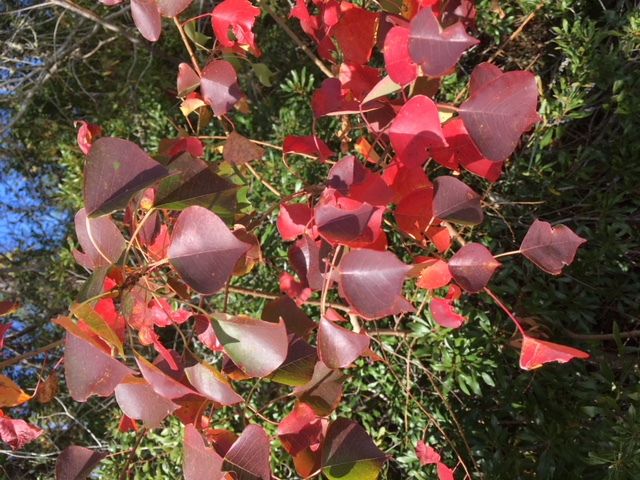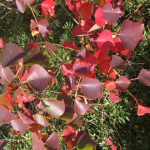
by Julie McConnell | Dec 1, 2017

Chinese tallow displays red fall color in North Florida. Photo: J_McConnell, UF/IFAS
In northwest Florida as we transition into fall, we don’t usually see a spectacular display of color change in the forest or our landscapes. Mixed in with the evergreen pines, oaks, and magnolias, we get sporadic spots of yellow and red from our native hickories, sweetgum, and sumac but otherwise it can be rather dull. It’s no wonder that people are reluctant to part with a blaze of red in their landscapes in the form of the invasive Chinese Tallow (Sapium sebiferum L. aka Triadica sebifera L.).
This fast growing, deciduous tree was initially introduced to the United States in 1776 by Benjamin Franklin. It was promoted by the U.S. Department of Agriculture in the early 1900s for the potential to create a soap industry. It was planted as an ornamental because it grows quickly in nearly any type of site condition, has attractive white fruit, and red fall color. Unfortunately, over the years it spread into numerous states and habitats unchecked displacing native vegetation and disrupting wildlife food sources. Eventually, it was recognized as an invasive pest and is currently listed as a noxious weed in Florida, Louisiana, Mississippi, and Texas.
Chinese Tallow is a prolific seed producer and is sexually mature as young as three years and may continue to produce viable seeds to the ripe age of 100. Although some birds eat the berries (part of the dispersal method), sap in the leaves and berries are poisonous to some other animals including cattle.
To prevent the continued spread of this plant, consider removing from your property and replacing with native species. Buy plants from reputable licensed nurseries with good weed management programs. Be able to recognize Chinese Tallow and do not accept plants from well-meaning gardeners who wish to share a foolproof shade tree!

by Larry Williams | Dec 1, 2017

Tulips at the U.S. Botanical Garden in Washington, D.C. Image Credit: IFAS Gardening Solutions
Q. I’ve seen the beautiful tulips of Amsterdam and would like to grow some here in North Florida. So I ordered some tulip bulbs. Can I plant these in North Florida?
A. Tulips are treated as annuals in Florida. We have two problems with tulips this far south. First, they do not receive enough cold weather to meet their requirements to bloom. Secondly, it gets hot quick enough in the spring to cause the foliage to die prematurely, which does not allow the tulip plants enough time to store sugars in the bulb to resume growth the following year. As a result, the bulbs become smaller and weak and flower poorly if at all the following year. At best you may get one to three years’ worth of blooms out of a tulip in our area no matter what you do. Most tulips will only bloom once in our area and then they are spent. Florida doesn’t provide the right kind of weather for tulips. We may have cold weather for a few nights. Then it warms again. This goes on all winter. Tulips need consistently cold weather in order to initiate flower buds.
You can provide an “artificial cold winter” by placing the bulbs in a refrigerator for about 8 weeks prior to planting. This requires purchasing the bulbs ahead of time in order to provide this chilling treatment and still have time to plant during late fall to mid-winter (late November to mid-January). Some nurseries sell pre-chilled bulbs, most don’t. The above treatment will meet their requirements for flowering but does nothing to offset the fact that it gets warm too quickly in the spring for tulips.
The few people that grow tulips in Florida either buy pre-chilled bulbs or place them in the refrigerator, plant them, enjoy their blooms the following spring and then throw them away. They treat them like annuals.



